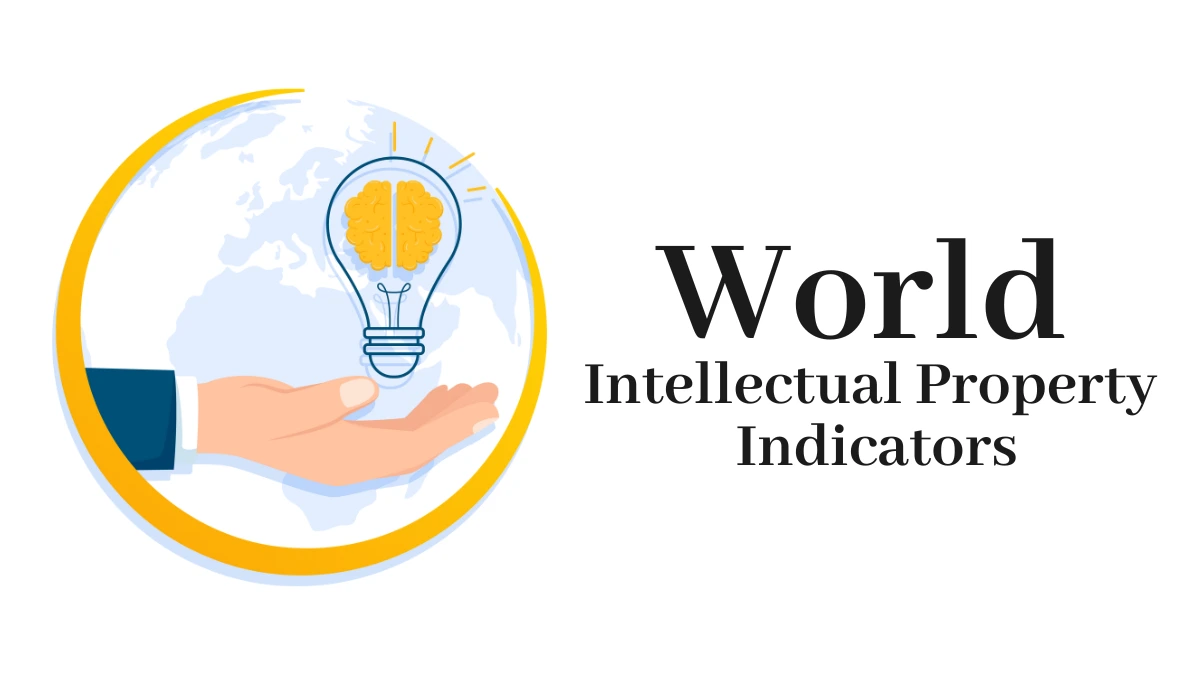- Courses
- GS Full Course 1 Year
- GS Full Course 2 Year
- GS Full Course 3 Year
- GS Full Course Till Selection
- Online Program
- GS Recorded Course
- NCERT (Recorded 500+ Hours)
- Polity Recorded Course
- Geography Recorded Course
- Economy Recorded Course
- AMAC Recorded Course
- Modern India, Post Independence & World History
- Environment Recoded Course
- Governance Recoded Course
- Science & Tech. Recoded Course
- International Relations and Internal Security Recorded Course
- Disaster Management Module Course
- Ethics Recoded Course
- Essay Recoded Course
- Current Affairs Recoded Course
- CSAT
- 5 LAYERED ARJUNA Mentorship
- Public Administration Optional
- ABOUT US
- OUR TOPPERS
- TEST SERIES
- FREE STUDY MATERIAL
- VIDEOS
- CONTACT US
World Intellectual Property Indicators 2024
World Intellectual Property Indicators 2024

Introduction
The World Intellectual Property Organization (WIPO) annually publishes the World Intellectual Property Indicators (WIPI) Report, offering insights into global Intellectual Property (IP) trends. The 2024 report highlights significant growth in patents, trademarks, and industrial designs, emphasizing the rise of emerging economies like India, which is now a key player in global IP filings.
Key Highlights of the WIPO Report 2024
-
Patent Filings:
- Global patent filings reached a record 3.55 million in 2023, growing by 2.7%.
- Top 3 contributors: China, US, Japan
- India's 17.2% growth (64,510 applications) marks its seventh consecutive year of rapid expansion, with resident applications driving this rise.
-
Trademark Filings:
- Global trademark filings declined slightly to 15.2 million, reflecting market adjustments.
- India ranked 4th globally, with a 6.1% increase, largely due to domestic businesses.
-
Industrial Designs:
- Global filings grew by 2.8%, reaching 1.5 million applications
- India saw an impressive 36.4% surge, led by industries such as textiles, fashion, healthcare, and electronics.
-
Patent-to-GDP Ratio:
- This metric measures innovation intensity relative to economic output
- South Korea leads with 7,309 patents per USD 100 billion GDP.
- India's ratio improved from 144 (2013) to 381 (2023), highlighting its innovation-driven economic transformation.
-
Gender Disparity Among Inventors:
- Women comprised only 17.7% of inventors named in Patent Cooperation Treaty (PCT) applications in 2023.
- Despite a gradual increase over the past decade, a significant gender gap remains in the field of innovation.
India’s Growing Influence in Global Innovation
India has strengthened its position as a global innovation hub, demonstrating remarkable progress:
- Ranked 6th globally in patent filings with an impressive 15.7% growth rate.
- Resident filings accounted for 55.2% of all patent applications, highlighting increased domestic research and development.
- Patent grants increased by 149.4%, showing improved processing efficiency and higher-quality innovations.
- Industrial design filings grew by 36.4%, reinforcing India's focus on product aesthetics and usability.
- 4th in trademark filings, with nearly 90% of applications originating from Indian businesses and entrepreneurs.
- Holds the second-largest number of active trademarks globally, exceeding 3.2 million registrations.
India’s Initiatives Supporting IP Growth
India has launched several policy and structural initiatives to promote innovation and IP protection:
- National IPR Policy (2016): Provides a structured framework to improve IP awareness, streamline enforcement, and encourage commercialization.
- Digitization and Modernization of IP Offices: Automation and digital processing have reduced application backlogs and improved patent grant efficiency.
- National Intellectual Property Awareness Mission (NIPAM): Has trained over 1 million students and entrepreneurs on IP protection and filing procedures.
- Technology Innovation Support Centres (TISC): Established across universities to support patent commercialization and boost research output.
- Startup India Initiative (2016): Offers tax incentives, funding support, and fast-track patent applications to encourage entrepreneurship and innovation.
- Atal Innovation Mission (AIM): Set up 10,000+ Atal Tinkering Labs and incubated 3,500+ startups, fostering a strong innovation culture in India.
- Expedited Patent Processing for Startups & MSMEs: The government has reduced patent application time from 5-7 years to under 2 years for startups and MSMEs.
Types of IPR and Laws in India
India protects various forms of Intellectual Property Rights (IPR):
- Patents: Provide exclusive rights to inventors for new, useful, and non-obvious inventions for 20 years under the Patents Act, 1970. This includes technological innovations, pharmaceuticals, and industrial products.
- Trademarks: Protect distinctive signs, logos, and brand names that distinguish products or services under the Trade Marks Act, 1999. Trademarks help businesses build brand identity and consumer trust.
- Copyrights: Protect original literary, artistic, musical, and cinematic works under the Copyright Act, 1957. This ensures authors, musicians, and artists retain control over their creative works.
- Industrial Designs: Safeguard the visual appearance and aesthetic aspects of products under the Designs Act, 2000. This includes shapes, configurations, surface patterns, and ornamentations used in manufacturing.
- Geographical Indications (GI): Provide protection to products with unique geographical origins, such as Darjeeling Tea, Mysore Silk, and Alphonso Mangoes, under the Geographical Indications of Goods (Registration and Protection) Act, 1999.
- Semiconductor Layout-Designs: Protect integrated circuit layouts and semiconductor chip designs, crucial for the electronics and IT industries, under the Semiconductor Integrated Circuits Layout-Design Act, 2000.
- Plant Varieties: Grant rights to farmers and breeders for new, distinct plant varieties, ensuring biodiversity conservation and agricultural innovation, under the Protection of Plant Varieties and Farmers’ Rights Act, 2001.
Challenges Faced by India in IP
Despite its progress, India faces several persistent challenges in IP development:
- Limited Awareness: Over 60% of SMEs lack comprehensive knowledge of IP protection and commercialization (FICCI, 2022).
- Procedural Delays: The average patent examination period is 42 months, significantly higher than the global average of 24-36 months (Indian Patent Office, 2022).
- Weak Enforcement: India ranked 43rd out of 55 in the U.S. Chamber International IP Index (2023), reflecting judicial inefficiencies and piracy concerns.
- Low International Filings: Indian entities file relatively fewer international patents, primarily due to high costs and procedural complexities.
- Infrastructure Limitations: The need for faster digitization and increased workforce in patent offices remains a key area of improvement.
Way Forward
Strategic policy interventions can strengthen India's IP landscape:
- Expand IP Awareness: Scale up NIPAM & SPRIHA programs to educate startups, SMEs, and academic institutions.
- Accelerate Digitization: Implement global best practices from Singapore, Japan, and South Korea to modernize patent processing systems.
- Enhance IP Enforcement: Establish specialized IP courts, inspired by the EUIPO model, to reduce infringement cases and strengthen judicial mechanisms.
- Support International Filings: Provide financial incentives and technical assistance to Indian startups seeking global IP protection, similar to China’s Patent Assistance Program.
- Encourage Industry Collaboration: Strengthen public-private partnerships to boost R&D investments and patent commercialization, drawing inspiration from the USA and Germany.
Conclusion
India’s expanding IP ecosystem signifies its emergence as a global innovation leader. Sustained policy reforms, infrastructure modernization, and international collaboration will further enhance India's intellectual property capabilities, driving economic growth and technological advancement.
|
Also Read |
|
| FREE NIOS Books | |




